Editorial
August has been good; I've made significant progress on the Cirrus, recovered most of my lost email, and made a break-thru in some image processing software that forms part of my day-job research. As usual, I worried that the content volume of the Model Engine News page for September would be scant, and as usual, it's not.
Spam remains the bane of my existence. The drug pushers have "found" the Model Engine News enquiries email address and it's getting a right hammering. Sniffing web pages for email addresses and testing that they don't bounce is a trivial exercise. I could change the enquiry address and obfuscate it in a way that's obvious to a human, but not so obvious to a Cylon, but I fear it would be a loosing battle. So for now, I'll live with it. I can detect the spam with relative ease (and I'm not going to say how on an open line  ), but as English is not the first language of many who 'mail me, I err on the optimistic side.
), but as English is not the first language of many who 'mail me, I err on the optimistic side.
This month is the first anniversary of Model Engine News moving to it's own URL (where has the time gone?). And I'm late getting the zip file of the previous four months updates put together, but never fear, it will appear... Real Soon Now.
Cirrus Progress
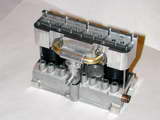
August disappeared under a mass of chips making one and a half Cirrus heads, together with the exhaust and inlet manifolds. There's still some work to do on the head and that requires a rather special slitting saw to form all the fins. I'm not 100% happy with head #2, cosmetically speaking, but all the holes are precisely in the right places, so barring a total catastrophe during fin-cutting, this will be it. In the process of making the heads and manifolds, I've discovered a number of missing and questionable dimensions in the SIC drawings, and some significant variation between them and the original Zimmerman drawings. No write-up on the head yet, but my "raw" file for the head and manifolds has 122 photographs so far (don't be alarmed, I shoot several pictures for each one published here). About the only thing left to complete are the head studs, so all being well, the engine is close to final assembly. There are a lot of little tasks left though. Engines like this are a BIG job.
Whozit?!
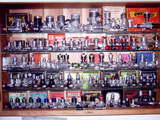
As a variation on the Watzit theme, this month we have a Whozit (Whose is it?) that we'd truly like an answer for. Collectors will quickly identify the engine collection as comprising examples of ED, Mills Brothers, and other allied engines, attractively presented with their original boxes, all in unusually pristine condition. The photo was sent in by Motor Boy Ken Croft and how he came by it is more of the mystery surrounding this item.
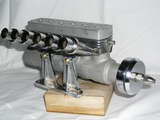 Just in case you can't get enough Watzits, Malcolm Stride in the UK has sent in some photos of a monster 60cc in-line six two-stroke that we'd like to know more about. Check out the "Eldon Who?" entry. Judging by the number of hits the pages receive, the Watzit pages are amongst the most popular on this site, so I'll bet many of you recall the PAYA that appeared there a couple of months back. Model Engine News has readers all over the planet, so we were pleased although not surprised to receive an email from a Spanish reader who was able to fill in all the details about this rare engine. So while you're pondering the Whozit and the Monster, have another look at the "hidden" answers for the PAYA.
Just in case you can't get enough Watzits, Malcolm Stride in the UK has sent in some photos of a monster 60cc in-line six two-stroke that we'd like to know more about. Check out the "Eldon Who?" entry. Judging by the number of hits the pages receive, the Watzit pages are amongst the most popular on this site, so I'll bet many of you recall the PAYA that appeared there a couple of months back. Model Engine News has readers all over the planet, so we were pleased although not surprised to receive an email from a Spanish reader who was able to fill in all the details about this rare engine. So while you're pondering the Whozit and the Monster, have another look at the "hidden" answers for the PAYA.
Bristol 2006
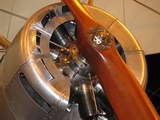
Yes, it's a Gnome Monosoupape, and avid aircraft spotters will recognize the airframe as a Sopwith Pup. Now for 10 points, which British museum is it hanging in? Sorry. Trick question. This is a model (1/4 scale), photographed by Motor Boy Eric Offen at the 2006 Bristol Model Engineering Exhibition. Click the pic or follow the link to view Eric's photos of some of the outstanding IC engines exhibited at Bristol 2006.
Gallery Updates
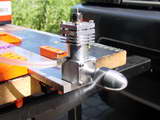
Another section of this web site that gets a right hammering of hits is the Gallery. Well for all Gallery lovers, we have a treat this month with three (3) new entries. These start with another Roy Clough designed Little Dragon made from the Free Plans available to all Model Engine News Members (and no, I still don't have mine running, that's Rich Klopp's engine in the photo). Next, there's a nice ML Midge in standard configuration, plus a FRV version, and finally, photos of a bunch of rather rare Hiness engines taken in a shop in Singapore (don't bother booking tickets, they are not for sale  ).
).
A Solid Mite
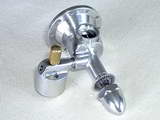
Not long ago, I had the chance to draw up the plans for the rather rare Majesco Mite. This one got under Les Stone's skin to the point where he had to scratch, so here is progress on his rendition, built from barstock rather than cast. Knowing Les, it will be running by this time next month (if it's not already!).
Serious Rods
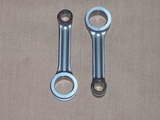
There are two groups of modelers that are pushing the performance of "model" two-strokes to the outer bounds of performance: Tether cars and hydroplanes. Free Flight F1J fans may think they are there too, but sorry, the other guys make their engines, so come back later (All right, there are exceptions in F1J community too. You can come back now). A reader sent me this link to a gallery of hydroplane builders. One in particular stands out for the quality and ambition of his engine work: Jim Allen. Have a look at how he makes conrods for .90 cuin engines that will turn 32,000 rpm and you'll understand what I mean. You might also like to visit the rest of the International Waters web site to get more inspiration.
Special Thanks to MEN Members
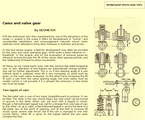
August marks the first anniversary of Model Engine News moving to it's own URL and a hosted web service. Although the MEN traffic qualifies for all kinds of "free" hosting, I don't want my readers insulted by the unconstrained and unrelated commercial content these services automatically inject. So I pay $$'s that are, to date, just offset by sales of the MEN Only CD. You guys (and the one gal, who bought it as a gift for her guy) are responsible for this site's continued existence, so to mark this auspicious occasion and say thanks for your support, I've created a new page that contains a series of model engine building related articles by Geometer. Access to this page is a Members Only deal; just use your normal username and password. You'll also discover who Geometer was and what else he did.
New Books and Magazines This Month

Not a lot entered The Library catalogue the past month except issue #117 of the Model Engineers' Workshop. This is a sister publication to the venerable Model Engineer, both now being published by Encanta Media in the UK. I always find something of interest in MEW, although any connection to IC engine building is usually tangential. One snippet from #117 worth passing on: MEW editor, David Fenner claims to have been dragged, kicking and screaming, into the 21st century. Specifically, he has opened his own personal website at www.davefenner.co.uk. Not a whole lot of model engineering content there yet, but he does have magazine to put together.
Engine Of The Month: SESQUI
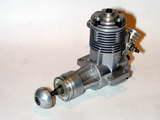
Thought I could save myself some time in a tight month by scanning another of David Jansen's freely piratable engine reviews. Won't make that mistake again. After scanning the text and taking shots of my own #119 engine (even more valuable as it came from the collection of our late friend, George Aldrich), I decided to add a scan of Ivor F's original SESQUI story scanned from a foolscap sheet of typing made on a clankety-bang typewriter, Roneoed, then munched by the odd silverfish. Bad move. The combination of holes in the paper, the oil stains, and Ivor's spelling (his attempt at phonetically modernizing the English language) gave the OCR software a fit. Ended up retyping it by hand. So click on the thumbnail, or use the DRJ Index to read how to make a small fortune from a major one.
Tech Tip of the Month
A little over two years ago, I added the CamCalc page to the Model Engine News website to assist builders produce tables of lift figures for machining harmonic cams by tangential milling. A number of readers have used this program and emailed their thanks, including the Model Engineer's current IC columnist, Nemett (designer of the NE15S that has been serialized in volume 196 of the ME over the past months).
By coincidence, I've been casually reading through volume 121 of the ME (the second half of 1959). These issues contain a series titled Workshop Hints and Tips by Geometer. This alias, I have on good authority, belonged to Ian Bradley, who also wrote prolifically in the ME under his own name. The use of a nom de plume by writers in the ME has been an honored tradition and a way of preventing over-exposure of valued authors. Many authors had multiple aliases, Bradley, for instance, teamed with Dr Norman Hallows to write extensively under the Duplex by-line. Their styles were sufficiently similar that readers of their Drill Sharpening Jig, Power Hacksaw, and many other construction series believed they were the work of a single individual. In all, Geometer wrote 424 articles, Duplex 212, and Bradley a further 106 under his own name.
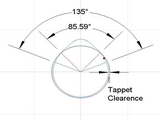 But I digress; Geometer's Workshop Hint on page 241 of volume 121, issue 3039, discusses machining harmonic cams in the lathe using an offset jig for the flanks, then worrying away the base circle by hand rotation of the chuck. Although rather labor intensive to my way of thinking, the explanation of the effect of valve clearance prompted me to revisit the text that accompanies the CamCalc program to explain why relieving the base circle is a Good Thing™ to do. Click the thumbnail to be taken to the added text, or visit the CamCalc page for the big picture. Members can view Geometer's original article on the new Geometer Page (And to answer the question before you ask it: you become a member by buying the CD of this site. Sales of the CD are what pays for keeping Model Engine News on-line).
But I digress; Geometer's Workshop Hint on page 241 of volume 121, issue 3039, discusses machining harmonic cams in the lathe using an offset jig for the flanks, then worrying away the base circle by hand rotation of the chuck. Although rather labor intensive to my way of thinking, the explanation of the effect of valve clearance prompted me to revisit the text that accompanies the CamCalc program to explain why relieving the base circle is a Good Thing™ to do. Click the thumbnail to be taken to the added text, or visit the CamCalc page for the big picture. Members can view Geometer's original article on the new Geometer Page (And to answer the question before you ask it: you become a member by buying the CD of this site. Sales of the CD are what pays for keeping Model Engine News on-line).
 Cirrus Progress
Cirrus Progress
 Whozit?!
Whozit?!
 Bristol 2006
Bristol 2006
 Gallery Updates
Gallery Updates
 A Solid Mite
A Solid Mite
 Serious Rods
Serious Rods
 Special Thanks to MEN Members
Special Thanks to MEN Members
 Editorial
Editorial
 New Books and Magazines This Month
New Books and Magazines This Month
 Engine Of The Month: SESQUI
Engine Of The Month: SESQUI
 Tech Tip of the Month
Tech Tip of the Month
 Standard Stuff
Standard Stuff
 ), but as English is not the first language of many who 'mail me, I err on the optimistic side.
), but as English is not the first language of many who 'mail me, I err on the optimistic side.










